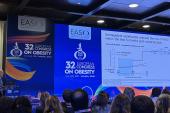Amylin Analogue Boosts Weight Loss When Added to GLP-1
Promising data from the REDEFINE trials show cagrilintide–semaglutide can also improve some CV risk factors.

Combination therapy with a long-acting amylin analogue and a glucagon-like peptide-1 (GLP-1) receptor agonist results in greater weight loss compared with placebo in people who have overweight or obesity, results of the REDEFINE 1 and REDEFINE 2 trials show. The data were positive no matter whether patients did, or did not, have diabetes.
For patients with diabetes, the experimental combination therapy, known as CagriSema (Novo Nordisk), resulted in a mean change in bodyweight of 13.7% over about 15 months compared with 3.4% with placebo.
The effect was even greater in patients without diabetes: in the intention-to-treat analysis, mean reductions were 20.4% and 3.0%, respectively, from baseline to week 68 in patients treated with cagrilintide–semaglutide and placebo (P < 0.001 for both comparisons). Cagrilintide–semaglutide also resulted in a greater change from baseline compared with semaglutide alone (-14.9% reduction) or cagrilintide alone (-11.5%).
Those reductions are “in the highest range of that observed with existing weight-loss interventions,” according to the REDEFINE investigators. Both studies were published June 22, 2025, in the New England Journal of Medicine, to coincide with presentations at the American Diabetes Association’s 85th Scientific Sessions.
The studies are part of the latest attempt to best or boost the efficacy of GLP-1 medications by adding agents that target additional pathways for weight loss. The REDEFINE investigators tested a fixed-dose combination therapy consisting of semaglutide (Wegovy; Novo Nordisk) and cagrilintide (Novo Nordisk), which has affinity for three amylin receptors and a calcitonin receptor.
“Some might have hypothesized that the two agents together would’ve shown even greater weight loss perhaps, but these numbers are just wonderful for clinical practice,” said Michael Blaha, MD (Johns Hopkins University School of Medicine, Baltimore, MD), who commented on the studies for TCTMD. “I think the main message is it’s just great to have so many options.”
The addition of cagrilintide, Blaha explained, further slows gastric emptying and induces satiety, creating a kind of “semaglutide squared effect.”
Beyond weight loss, the studies show that the novel agent led to additive reductions in HbA1c and blood pressure, and further improved other surrogate endpoints pertinent to cardiologists, in both diabetic and nondiabetic patients. The side effect profile was generally consistent with the GLP-1 drugs alone.
CagriSema is not currently approved by the US Food and Drug Administration or any other regulatory body.
REDEFINE 1
Led by W. Timothy Garvey, MD (University of Alabama at Birmingham), the REDEFINE 1 study randomized 3,417 adults (mean age 47 years; 67.6% women) with overweight or obesity to receive once-weekly injections of cagrilintide–semaglutide (2.4 mg of each drug combined), semaglutide (2.4 mg alone), cagrilintide (2.4 mg alone), or placebo in addition to standardized lifestyle intervention. Overweight or obesity was defined as a body mass index of 30 kg/m2 or greater, or 27 or greater with at least one obesity-related comorbidity (hypertension, dyslipidemia, or obstructive sleep apnea).
When analyzed based on patients taking the drugs as intended, the estimated percent change in bodyweight from baseline to week 68 was 22.7% with cagrilintide–semaglutide, 16.1% with semaglutide, 11.8% with cagrilintide, and 2.3% with placebo. The absolute mean reduction in body weight with cagrilintide–semaglutide was 21.6 kg.
More participants in the cagrilintide–semaglutide group achieved weight loss targets of at least 5%, 20%, 25%, and 30% compared with placebo. More than one-third of the cagrilintide–semaglutide group achieved a 25% or greater weight loss versus about 15% of the semaglutide alone group, and 19% achieved a 30% or greater weight loss compared with 8.7% of those on semaglutide alone. In the group on cagrilintide alone, 6.5% and 1.6%, respectively, achieved 25% and 30% or greater weight loss.
It’s just great to have so many options. Michael Blaha
Mean systolic blood pressure reductions from baseline to week 68 were 9.9 mm Hg in the cagrilintide–semaglutide group and 3.2 mm Hg with placebo (P < 0.001), with corresponding reductions in mean diastolic blood pressure of 5.1 mm Hg and 1.9 mm Hg. Compared with placebo, the cagrilintide–semaglutide group also saw greater reductions in measures of glycated hemoglobin, glucose, insulin, lipids, and C-reactive protein.
Among participants with prediabetes at baseline, normoglycemia by 15 months was achieved in 87.7% of those who received cagrilintide–semaglutide versus 32.2% of those who received placebo.
Compared with placebo, the combination therapy group also had better physical function scores as measured by the Impact of Weight on Quality of Life-Lite Clinical Trials Version (IWQOL-Lite-CT) physical function score and the 36-Item Short-Form Health Survey (SF-36).
REDEFINE 2
For REDEFINE 2, Melanie J. Davies, MD (Leicester General Hospital, England), and colleagues randomized 1,206 patients (mean age 56 years; 47% women) with overweight or obesity plus a diagnosis of type II diabetes to cagrilintide–semaglutide or placebo in addition to standardized lifestyle intervention. The mean duration of diabetes was 8.5 years, and approximately 40% of patients were on either one or more oral glucose-lowering agents, most commonly metformin.
As with the nondiabetic population, the REDEFINE 2 participants also were more likely to achieve weight loss targets of at least 5%, 10%, 15%, or 20% with cagrilintide–semaglutide than with placebo.
Beyond weight loss, those on cagrilintide–semaglutide had a greater mean reduction in glycated hemoglobin levels from baseline to 15 months compared with placebo (P < 0.001). Additionally, 73.5% of patients on CagriSema achieved an HbA1c of ≤ 6.5% versus 15.9% in the placebo group, with the investigators noting that decreases in levels of fasting plasma glucose and fasting serum insulin also appeared greater in the combination therapy group.
In the subset on oral glucose-lowering agents, more than one third of patients on cagrilintide–semaglutide had a decrease in medication intensity requirements, which was mirrored by a similar increase in medication intensity in the placebo group.
Mean systolic blood pressure reductions from baseline to week 68 were about 4 points greater with cagrilintide–semaglutide compared with placebo. Additionally, improvements in physical function scores compared with placebo were similar to those seen in the nondiabetic population.
Adverse event rates in both REDEFINE 1 and REDEFINE 2 were primarily confined to GI symptoms, which occurred with the combination therapy in 72.5% of diabetic patients and 80% of those without diabetes.
What’s Next?
Both studies add to accumulating evidence of broad cardiometabolic benefits of GLP-1 agents beyond diabetes and obesity, including in areas such as sleep apnea, atrial fibrillation, and heart failure.
To TCTMD, Blaha said further research on cagrilintide–semaglutide could shed light on whether the cardiovascular benefits are in line with those of semaglutide and tirzepatide (Zepbound; Eli Lilly), or perhaps even better.
Having more options for patients to achieve weight loss goals is important, he added, in light of common issues like patient intolerance, insurance coverage, and interindividual variability of effectiveness.
As with other GLP-1 agents, the REDEFINE investigators say, long-term treatment will probably be required to sustain the observed clinical benefits of cagrilintide–semaglutide seen in the trials. Rather than uptitrating patients on a schedule, the investigators allowed them to remain on their target dose or decrease it if they chose, which they believe contributed to low rates of discontinuation in the trial. The trialists see this as important for clinical practice, since the benefits of treatment did not appear to be compromised by taking submaximal doses.
L.A. McKeown is a Senior Medical Journalist for TCTMD, the Section Editor of CV Team Forum, and Senior Medical…
Read Full BioSources
Garvey WT, Blüher M, Contreras CKO, et al. Coadministered cagrilintide and semaglutide in adults with overweight or obesity. N Engl J Med. 2025;Epub ahead of print.
Davies MJ, Bajaj HS, Broholm C, et al. Cagrilintide–semaglutide in adults with overweight or obesity and type 2 diabetes. N Engl J Med. 2025;Epub ahead of print.
Disclosures
- Both trials were funded by Novo Nordisk.
- Garvey reports consulting for Alnylam, Boehringer Ingelheim, Eli Lilly, Hoffmann-La Roche, Fractyl Health, Gan & Lee, Inogen, Keros Therapeutics, Neurocrine Biosciences, Novo Nordisk, Regeneron, and Zealand Pharma.
- Davies reports consulting for AbbVie, Biomea Fusion, EktaH, GlaxoSmithKline, Regeneron, Roche, and Sanofi-Aventis; and serving on scientific advisory boards for Novo Nordisk.
- Blaha reports serving on scientific advisory boards for Eli Lilly and Novo Nordisk.





Comments